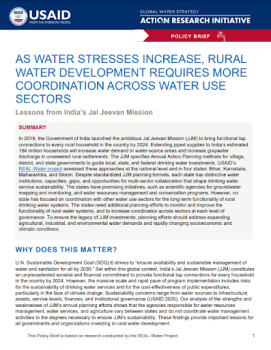As Water Stresses Increase, Rural Water Development Requires More Coordination Across Water Use Sectors: Lessons from India’s Jal Jeevan Mission
In 2019, the Government of India launched the ambitious Jal Jeevan Mission (JJM) to bring functional tap connections to every rural household in the country by 2024. Extending piped supplies to India’s estimated 194 million households will increase water demand in water-scarce areas and increase graywater discharge in unsewered rural settlements. The JJM specifies Annual Action Planning methods for village, district, and state governments to guide local, state, and federal drinking water investments. USAID’s REAL-Water project assessed these approaches at the national level and in four states: Bihar, Karnataka, Maharashtra, and Sikkim. Despite standardized JJM planning formats, each state has distinctive water institutions, capacities, gaps, and opportunities for multi-sector collaboration that shape drinking water service sustainability. The states have promising initiatives, such as scientific agencies for groundwater mapping and monitoring, and water resources management and conservation programs. However, no state has focused on coordination with other water use sectors for the long-term functionality of rural drinking water systems. The states need additional planning efforts to monitor and improve the functionality of rural water systems, and to increase coordination across sectors at each level of governance. To ensure the legacy of JJM investments, planning efforts should address expanding agricultural, industrial, and environmental water demands and rapidly changing socioeconomic and climatic conditions.


